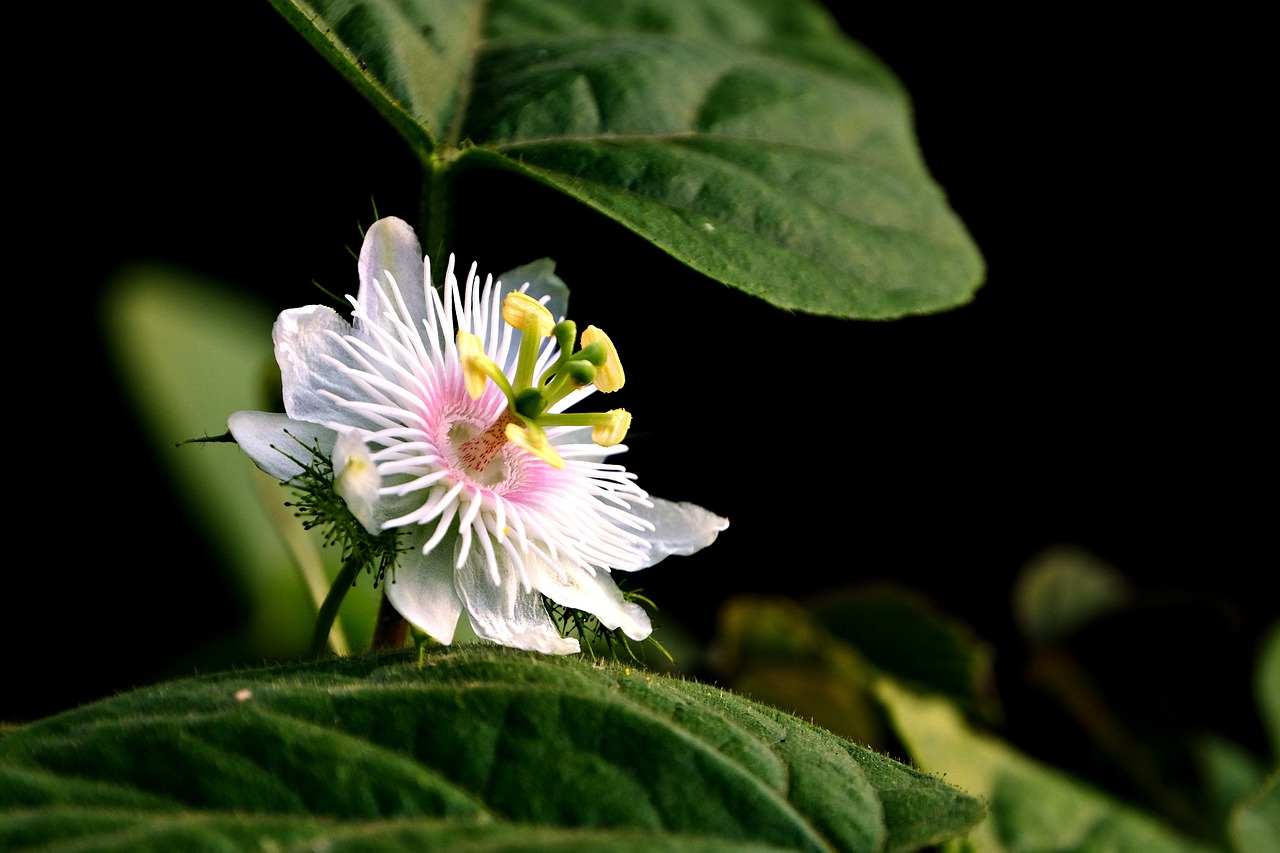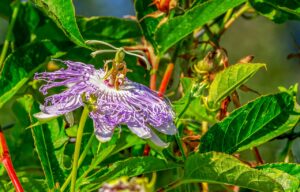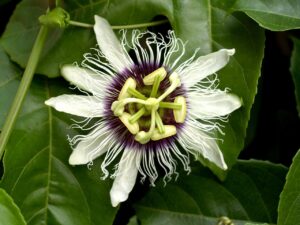Passiflora (Passion Vine)
Overview
Passiflora, also known as Passion Vine, encompasses over 500 species of perennial vines known for their beautiful flowers and climbing nature. These plants are native to tropical and subtropical climates, with some species found in temperate zones. The Passionflower has been valued for both its symbolic significance and traditional medicinal benefits, particularly as a soothing agent for anxiety and sleep disorders.
Common name(s): Passion Vine, Passionflower, Maypop
Scientific name: Passiflora spp.

Characteristics
Known for its complex flowers, climbing growth through tendrils, and traditional use in herbal medicine for its sedative and anxiolytic properties.
Region
Primarily in tropical and subtropical regions, with some species in temperate zones.
Natural Habitat
Primarily in tropical and subtropical regions, often in open fields, forest edges, and along roadsides.
Cultivation
Prefers full sun to partial shade, regular watering but well-drained soil, and fertile, loamy to sandy soil with a pH between 6.5 and 7.5.
Traditional Usage
Traditionally, the uses of Passion Vine in various cultures have been as rich in their diversity as in their symbolism. Here are a few ways historical populations have utilized this plant:
- Sedative: Native American tribes used Passion Vine as a natural sedative to encourage sleep and calm the nerves1.
- Symbolic Value: Spanish Christian missionaries in the 15th and 16th centuries found meaning within the floral parts, linking it to the Passion of Christ5.
- Anxiety Relief: Its anxiolytic properties have made it a go-to remedy for individuals dealing with anxiety4.
- Nervine: As a recognized nervine, Passion Vine has been trusted to support the overall nervous system4.
Whether in the form of a tea or an extract, Passiflora incarnata, often found in the southeastern United States, continues to be a vital part of herbal medicine traditions.
Historical Usage
Symbolically linked to the Passion of Christ and traditionally used by Native Americans as a sedative and sleep aid.
Common Usage
Used as a herbal remedy for anxiety, insomnia, and nervous system support.
Effects
Passion Vine, also known as Passionflower, often garners attention for its stunning beauty and potential health benefits. Traditionally used for its soothing properties, this versatile plant is primarily associated with relaxation and stress relief. Despite being more commonly utilized in teas and extracts, here are some of the general effects Passion Vine may have when used in herbal preparations:
- Promotes a sense of calm, potentially helping to reduce anxiety levels.
- Known for its sedative qualities, it may improve sleep quality.
- May act as a supportive agent for the nervous system, traditionally classified as a nervine.
- Contains a range of phytochemicals that could contribute to its calming effects, including flavonoids and alkaloids like harman and harmine.
- Users may experience relaxation and a feeling of well-being.
These effects are widely reported among individuals using Passionflower in conventional forms. It’s important to note that the majority of evidence for these effects comes from its ingestion rather than from smoking. People considering using Passion Vine for its anxiolytic or sedative effects should do so mindful of dosage and potential interactions with other medications, and consult a healthcare provider first.

Passion vine celebrated for its soothing properties and potential to alleviate restlessness.
Effects when smoking
Smoking Passion Vine can lead to several noticeable effects. The herb is well-regarded for its calming properties, which when smoked, might provide a mild sedative influence. However, as the practice isn’t extensively studied or widely recommended, the following points are based on limited or anecdotal evidence rather than robust scientific research.
- Smoking Passion Vine may induce a light sedative effect, aiding in relaxation and stress relief.
- It could potentially help to reduce symptoms of anxiety, contributing to an overall sense of calm.
- There may be a mild improvement in sleep quality due to its calming effects, although most evidence supports its use in tea form for this benefit.
- Users should note the possibility of experiencing dizziness or confusion at higher doses4.
- Certain medications, particularly sedatives and blood thinners, may have interactions with compounds in Passion Vine, necessitating caution4.
It’s worth noting that while traditional uses of Passion Vine typically involve oral ingestion, such as teas or tinctures, smoking the herb is a departure from these methods and lacks similar backing by clinical research. Those interested in smoking Passion Vine should proceed with caution and consult with a healthcare provider, especially if using other medications or if pregnant or breastfeeding4.
Flavor Profile
Earthy and mildly floral taste.
Edible Parts
Fruit
Effects when Smoked
Anecdotal reports suggest mild sedative effects when smoked, but lack scientific documentation.
User Experiences
Users generally report reduced anxiety and improved sleep quality, with less common mentions of mild sedative effects when smoked.
Medicinal Benefits
Passion Vine, also known as Passionflower, is celebrated for its calming properties and potential medicinal benefits. Traditionally used to alleviate symptoms of anxiety and improve sleep, here is a breakdown of its purported therapeutic effects:
- Anxiolytic properties: May help reduce anxiety and stress levels.
- Sedative qualities: Often used to promote a peaceful sleep and as a natural sleep aid.
- Nervine capabilities: Thought to support and soothe the nervous system.
These benefits are largely attributed to the plant’s phytochemicals, including flavonoids and various alkaloids, which are believed to work synergistically to enhance its sedative and anxiolytic effects3 4. While it’s important to consult with a healthcare provider before using Passionflower, especially for individuals on medication or pregnant women, its traditional applications have been endorsed by users for centuries4.
History and Folklore
Historically, the Passion Vine has been embraced for its powerful symbolism and medicinal properties. In the Americas, its use dates back to Native American tribes who valued the Passiflora incarnata, also known as Maypop, for its soothing effects, utilizing it as a sedative and sleep aid[1]. Across the Atlantic, in the 15th and 16th centuries, Spanish Christian missionaries found significance in the unique structure of the Passion Vine’s flower, linking it to the Passion of Christ and giving the vine its evocative name[5].

The Passion Vine, venerated for its sedative properties by Native Americans and symbolically linked to the Passion of Christ by Spanish missionaries, exhibits a stunning flower embodying deep historical and cultural significance.
Side Effects and Contraindications
Side Effects and Contraindications of Passionflower
While Passionflower is known for its calming effects, it’s important to be aware of potential side effects and circumstances where it should be avoided. Common side effects may include dizziness, confusion, and sedation. These are typically a result of higher doses4.
Contraindications: Passionflower should be used with caution, or not at all, by certain groups:
- Individuals taking sedatives or blood thinning medications may experience increased effects or risk of adverse reactions4.
- It is not recommended for pregnant or breastfeeding women due to the risk of potential harm to the baby or interference with pregnancy4.
Always consult with a healthcare provider before incorporating Passionflower into your routine, especially if you fall into any of the mentioned categories.
Legal Status
Passion Vine is legally accessible in numerous countries, including the United States. It can typically be found in health food stores and pharmacies as a dietary supplement, available for purchase without prescription. This status enables easy acquisition for those interested in exploring its traditional medicinal applications. As regulations can vary by region and over time, it is important to stay informed about the most current laws pertaining to herbal substances in your area[4].
References
1. Passionflower: Plant Care & Growing Guide – The Spruce, https://www.thespruce.com/passion-flowers-1403114
2. Passiflora incarnata – Plant Finder – Missouri Botanical Garden, https://www.missouribotanicalgarden.org/PlantFinder/PlantFinderDetails.aspx?kempercode=q280
3. Passiflora edulis – Wikipedia, https://en.wikipedia.org/wiki/Passiflora_edulis
4. Passionflower: 4 Benefits, Dosage, & Safety | The Botanical Institute, https://botanicalinstitute.org/passionflower/
5. Passiflora – Wikipedia, https://en.wikipedia.org/wiki/Passiflora
Image Credit: ignartonosbg
Image Credit: Couleur
Image Credit: 41330
Nicolas Duval
Nicolas is a passionate advocate for nature and the art of wildcrafting. His dedication shines through in Wildcraftia, a website he meticulously crafted to serve as a haven for nature enthusiasts worldwide. Driven by a deep appreciation for nature’s connection to humanity, Nicolas embarked on his journey in 2011 with SmokableHerbs, a platform showcasing his love for nature’s bounty. Building upon this foundation, he established Smokably, a thriving online store offering premium herbs and blends to a global audience.
